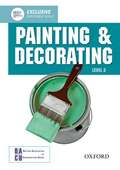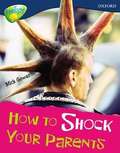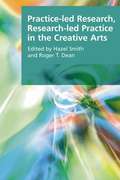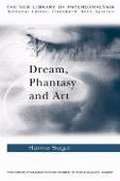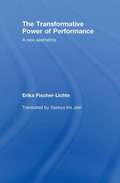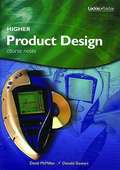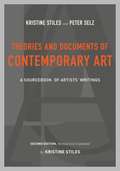- Table View
- List View
Weeping woman by Pablo Picasso (Large Print)
by Rnib BookshareThese pages show a build up of an image of the abstract cubist painting. This is a style where different left and right views are combined into one image. It is a multi-page image set on four pages. There is a locator dot shown on each page, which will be at the top left when the image is the correct way up. Each image is surrounded by an image border. Weeping woman facial features and hand only. This is an image of an oil painting of a woman's head and shoulders. At the top of the page she is wearing a red hat with a yellow bow and a blue flowerâ to the left centre of the hat. The hat has a thick yellow line running along the top and horizontally through the middle on the left. To the left she has medium length hair and a short bang of hair at the top of her forehead. To the mid right of the medium length hair is her ear. Up and right from here the pupils of her eyes are jagged black star shapes surrounded by a heavy oval line. Lots of eyelashes are shown. Up from each eye there is an eyebrow, the one on the right is heavier. The nose is not clearly shown. The lower part of the face the mouth and chin are turned to face to the right slightly. The lips are parted so the upper and lower teeth of the front and right side of the mouth can be found. To the right of the mouth the left hand is shown empty with three fingertips and nails. The thumb is shown to the right and down from the chin. The wrist is down from the thumb coming from a sleeve cuff shown by a thick line. To the right, below and to the left is the cloth of the womanâ TMs dress. It has decorations shown by heavy dashed lines. Weeping woman simplified. This image is the same as the first image but with more detail around the eyes, and the hand now holds a crumpled handkerchief. There are three tears below the eye on the left and one below the eye on the right. The track of a fifth tear goes left from the eye on the left and down past the ear. At the end of the track the tear is shown as a small circle. Right from this tear is the angular thumb of the right hand, the rest of the hand is not shown. Weeping woman the full painting without background. This image is the same as the second image but with more detail below the eyes and on the neck. The area down from the eyes, the chin and the left thumb is without texture/colour and is a stark pattern of white, black and a very dark blue. Patches of colour and lines around the eyes convey the wrinkled despair of the distraught woman. It shows the almost violent grief of the weeping woman. Weeping woman by Picasso the full painting. This image is the same as the third image but with the detail of the background. On the left, the womans hair is shown as thick black lines with streaks of blue, purple and greenish yellow. Her ear is yellow and green. This side of her face is yellow with a purple patch under the eye and tear track on the left. Above her eye on the left is a patch of green and up from this is an eyebrow. Just to the right of the green patch is a patch of purple surrounded by a thick black line. Down from this and to the right of the eye on the left is a sort of yellow cup facing up. To the right of this is another yellow cup facing to the right. Above the eye on the right is a triangle of black on the left and one of yellow to the right. Up from this triangle is a thick black eyebrow. Below the eyes is a pattern of thick black lines and the rounded tear drops. The side of the face on the right is green with a purple triangle below the eye. The left hand in the bottom right of the image is green with yellow fingernails. The palm and wrist of the image is yellow. The dress is black with a pattern of white brush marks making geometric shapes. Immediately above the womans shoulders is an area of bright red in the background. Up from this on the right of the woman's head a broad stripe of brown runs across the image. It is trimmed with an orange line up and a yellow line down from it. Up from the small patch of red to the left of the womans head a broad stripe of brown runs diagonally up to the left. It is...
Weeping woman by Pablo Picasso (UEB contracted)
by Rnib BookshareThese pages show a build up of an image of the abstract cubist painting. This is a style where different left and right views are combined into one image. It is a multi-page image set on four pages. There is a locator dot shown on each page, which will be at the top left when the image is the correct way up. Each image is surrounded by an image border. Weeping woman facial features and hand only. This is an image of an oil painting of a woman's head and shoulders. At the top of the page she is wearing a red hat with a yellow bow and a blue flowerâ to the left centre of the hat. The hat has a thick yellow line running along the top and horizontally through the middle on the left. To the left she has medium length hair and a short bang of hair at the top of her forehead. To the mid right of the medium length hair is her ear. Up and right from here the pupils of her eyes are jagged black star shapes surrounded by a heavy oval line. Lots of eyelashes are shown. Up from each eye there is an eyebrow, the one on the right is heavier. The nose is not clearly shown. The lower part of the face the mouth and chin are turned to face to the right slightly. The lips are parted so the upper and lower teeth of the front and right side of the mouth can be found. To the right of the mouth the left hand is shown empty with three fingertips and nails. The thumb is shown to the right and down from the chin. The wrist is down from the thumb coming from a sleeve cuff shown by a thick line. To the right, below and to the left is the cloth of the womanâ TMs dress. It has decorations shown by heavy dashed lines. Weeping woman simplified. This image is the same as the first image but with more detail around the eyes, and the hand now holds a crumpled handkerchief. There are three tears below the eye on the left and one below the eye on the right. The track of a fifth tear goes left from the eye on the left and down past the ear. At the end of the track the tear is shown as a small circle. Right from this tear is the angular thumb of the right hand, the rest of the hand is not shown. Weeping woman the full painting without background. This image is the same as the second image but with more detail below the eyes and on the neck. The area down from the eyes, the chin and the left thumb is without texture/colour and is a stark pattern of white, black and a very dark blue. Patches of colour and lines around the eyes convey the wrinkled despair of the distraught woman. It shows the almost violent grief of the weeping woman. Weeping woman by Picasso the full painting. This image is the same as the third image but with the detail of the background. On the left, the womans hair is shown as thick black lines with streaks of blue, purple and greenish yellow. Her ear is yellow and green. This side of her face is yellow with a purple patch under the eye and tear track on the left. Above her eye on the left is a patch of green and up from this is an eyebrow. Just to the right of the green patch is a patch of purple surrounded by a thick black line. Down from this and to the right of the eye on the left is a sort of yellow cup facing up. To the right of this is another yellow cup facing to the right. Above the eye on the right is a triangle of black on the left and one of yellow to the right. Up from this triangle is a thick black eyebrow. Below the eyes is a pattern of thick black lines and the rounded tear drops. The side of the face on the right is green with a purple triangle below the eye. The left hand in the bottom right of the image is green with yellow fingernails. The palm and wrist of the image is yellow. The dress is black with a pattern of white brush marks making geometric shapes. Immediately above the womans shoulders is an area of bright red in the background. Up from this on the right of the woman's head a broad stripe of brown runs across the image. It is trimmed with an orange line up and a yellow line down from it. Up from the small patch of red to the left of the womans head a broad stripe of brown runs diagonally up to the left. It is...
Weeping woman by Pablo Picasso (UEB uncontracted)
by Rnib BookshareThese pages show a build up of an image of the abstract cubist painting. This is a style where different left and right views are combined into one image. It is a multi-page image set on four pages. There is a locator dot shown on each page, which will be at the top left when the image is the correct way up. Each image is surrounded by an image border. Weeping woman facial features and hand only. This is an image of an oil painting of a woman's head and shoulders. At the top of the page she is wearing a red hat with a yellow bow and a blue flowerâ to the left centre of the hat. The hat has a thick yellow line running along the top and horizontally through the middle on the left. To the left she has medium length hair and a short bang of hair at the top of her forehead. To the mid right of the medium length hair is her ear. Up and right from here the pupils of her eyes are jagged black star shapes surrounded by a heavy oval line. Lots of eyelashes are shown. Up from each eye there is an eyebrow, the one on the right is heavier. The nose is not clearly shown. The lower part of the face the mouth and chin are turned to face to the right slightly. The lips are parted so the upper and lower teeth of the front and right side of the mouth can be found. To the right of the mouth the left hand is shown empty with three fingertips and nails. The thumb is shown to the right and down from the chin. The wrist is down from the thumb coming from a sleeve cuff shown by a thick line. To the right, below and to the left is the cloth of the womanâ TMs dress. It has decorations shown by heavy dashed lines. Weeping woman simplified. This image is the same as the first image but with more detail around the eyes, and the hand now holds a crumpled handkerchief. There are three tears below the eye on the left and one below the eye on the right. The track of a fifth tear goes left from the eye on the left and down past the ear. At the end of the track the tear is shown as a small circle. Right from this tear is the angular thumb of the right hand, the rest of the hand is not shown. Weeping woman the full painting without background. This image is the same as the second image but with more detail below the eyes and on the neck. The area down from the eyes, the chin and the left thumb is without texture/colour and is a stark pattern of white, black and a very dark blue. Patches of colour and lines around the eyes convey the wrinkled despair of the distraught woman. It shows the almost violent grief of the weeping woman. Weeping woman by Picasso the full painting. This image is the same as the third image but with the detail of the background. On the left, the womans hair is shown as thick black lines with streaks of blue, purple and greenish yellow. Her ear is yellow and green. This side of her face is yellow with a purple patch under the eye and tear track on the left. Above her eye on the left is a patch of green and up from this is an eyebrow. Just to the right of the green patch is a patch of purple surrounded by a thick black line. Down from this and to the right of the eye on the left is a sort of yellow cup facing up. To the right of this is another yellow cup facing to the right. Above the eye on the right is a triangle of black on the left and one of yellow to the right. Up from this triangle is a thick black eyebrow. Below the eyes is a pattern of thick black lines and the rounded tear drops. The side of the face on the right is green with a purple triangle below the eye. The left hand in the bottom right of the image is green with yellow fingernails. The palm and wrist of the image is yellow. The dress is black with a pattern of white brush marks making geometric shapes. Immediately above the womans shoulders is an area of bright red in the background. Up from this on the right of the woman's head a broad stripe of brown runs across the image. It is trimmed with an orange line up and a yellow line down from it. Up from the small patch of red to the left of the womans head a broad stripe of brown runs diagonally up to the left. It is...
Mona Lisa by Leonardo da Vinci (Large Print)
by Rnib BookshareThis is an image of an oil painting of a woman. It was painted in 1505. The original is fairly dark from varnish with subdued colours. There is a locator dot shown, which will be at the top left when the image is the right way up. The woman is facing forward and shown from the waist up with her head in the top centre of the page. Her face is pointed slightly to the left but her eyes are turned to look straight at you. She has long dark brown hair with a hint of red. Both arms are bent at the elbow and her hands are crossed in the bottom centre of the page. She gently rests on the arm to the right. She is wearing a dark green dress with loose folds of cloth and paler sleeves on her lower arms. She has the famous slight enigmatic smile. The background is a view of a distant soft landscape comprising forests, lakes, a track and an arched bridge. It is a range of greens and blue-greens with quite a bright blue for the water.
Mona Lisa by Leonardo da Vinci (UEB contracted)
by Rnib BookshareThis is an image of an oil painting of a woman. It was painted in 1505. The original is fairly dark from varnish with subdued colours. There is a locator dot shown, which will be at the top left when the image is the right way up. The woman is facing forward and shown from the waist up with her head in the top centre of the page. Her face is pointed slightly to the left but her eyes are turned to look straight at you. She has long dark brown hair with a hint of red. Both arms are bent at the elbow and her hands are crossed in the bottom centre of the page. She gently rests on the arm to the right. She is wearing a dark green dress with loose folds of cloth and paler sleeves on her lower arms. She has the famous slight enigmatic smile. The background is a view of a distant soft landscape comprising forests, lakes, a track and an arched bridge. It is a range of greens and blue-greens with quite a bright blue for the water.
Mona Lisa by Leonardo da Vinci (UEB uncontracted)
by Rnib BookshareThis is an image of an oil painting of a woman. It was painted in 1505. The original is fairly dark from varnish with subdued colours. There is a locator dot shown, which will be at the top left when the image is the right way up. The woman is facing forward and shown from the waist up with her head in the top centre of the page. Her face is pointed slightly to the left but her eyes are turned to look straight at you. She has long dark brown hair with a hint of red. Both arms are bent at the elbow and her hands are crossed in the bottom centre of the page. She gently rests on the arm to the right. She is wearing a dark green dress with loose folds of cloth and paler sleeves on her lower arms. She has the famous slight enigmatic smile. The background is a view of a distant soft landscape comprising forests, lakes, a track and an arched bridge. It is a range of greens and blue-greens with quite a bright blue for the water.
The Kiss by Auguste Rodin (Large Print)
by Rnib BookshareThis is an image of a marble sculpture of a man and a woman sitting on a large rock. It was finished in 1904. The front of the sculpture is on the left and a close-up of the right side in an image border is on the right of the page. There is a locator dot shown, which will be at the top left when the image is the right way up. On the left of the page the couple are sitting with their lower bodies facing forward and their upper bodies facing each other. The man is on the left and the woman on the right. They are naked and in an embrace. At the top of the image the man's head is facing to the right and down. A lot of his face cannot be found as the womans arm hides it. Only the upper part of his right ear can be found. In this view his left arm cannot be found. His right hand is holding the womans left hip. His left leg is partly obscured by the womans legs which hang over it. At the top of the image the womans left arm is wrapped around the mans neck. It obscures most of her face as well as his. Her hand is behind his neck and cannot be found. Her breasts are seen from a three quarter view so only the nearest nipple is showing. Her right leg crosses his left leg and her left foot rest on his left foot. In the image on the right not all the sculpture is shown. It is a view from the right side of the sculpture. The man is facing forward and the woman facing away at an angle so her back can be found in the centre of the image. At the top of the image the mans face is facing to the right and slightly down. His ear to the left, an eye, the upper nose and the other eye on the right of the face can be found. The lower part of his face and mouth cannot be found as it is obscured as the woman kisses him. Her head is on its side, the top of her head is to the right and her chin to the left. She is facing away towards the man so only one ear can be found and her eyes cannot be found. Her left arm goes around behind his head so the lower arm and hand cannot be found. On the left, the man's right arm goes behind the woman's hip so his hand cannot be found. She rests on her folded right elbow so this hand is not shown either. On the right the man's left arm and hand rest on the rock. There is a small piece of carved cloth in his elbow.
The Kiss by Auguste Rodin (UEB contracted)
by Rnib BookshareThis is an image of a marble sculpture of a man and a woman sitting on a large rock. It was finished in 1904. The front of the sculpture is on the left and a close-up of the right side in an image border is on the right of the page. There is a locator dot shown, which will be at the top left when the image is the right way up. On the left of the page the couple are sitting with their lower bodies facing forward and their upper bodies facing each other. The man is on the left and the woman on the right. They are naked and in an embrace. At the top of the image the man's head is facing to the right and down. A lot of his face cannot be found as the womans arm hides it. Only the upper part of his right ear can be found. In this view his left arm cannot be found. His right hand is holding the womans left hip. His left leg is partly obscured by the womans legs which hang over it. At the top of the image the womans left arm is wrapped around the mans neck. It obscures most of her face as well as his. Her hand is behind his neck and cannot be found. Her breasts are seen from a three quarter view so only the nearest nipple is showing. Her right leg crosses his left leg and her left foot rest on his left foot. In the image on the right not all the sculpture is shown. It is a view from the right side of the sculpture. The man is facing forward and the woman facing away at an angle so her back can be found in the centre of the image. At the top of the image the mans face is facing to the right and slightly down. His ear to the left, an eye, the upper nose and the other eye on the right of the face can be found. The lower part of his face and mouth cannot be found as it is obscured as the woman kisses him. Her head is on its side, the top of her head is to the right and her chin to the left. She is facing away towards the man so only one ear can be found and her eyes cannot be found. Her left arm goes around behind his head so the lower arm and hand cannot be found. On the left, the man's right arm goes behind the woman's hip so his hand cannot be found. She rests on her folded right elbow so this hand is not shown either. On the right the man's left arm and hand rest on the rock. There is a small piece of carved cloth in his elbow.
The Kiss by Auguste Rodin (UEB uncontracted)
by Rnib BookshareThis is an image of a marble sculpture of a man and a woman sitting on a large rock. It was finished in 1904. The front of the sculpture is on the left and a close-up of the right side in an image border is on the right of the page. There is a locator dot shown, which will be at the top left when the image is the right way up. On the left of the page the couple are sitting with their lower bodies facing forward and their upper bodies facing each other. The man is on the left and the woman on the right. They are naked and in an embrace. At the top of the image the man's head is facing to the right and down. A lot of his face cannot be found as the womans arm hides it. Only the upper part of his right ear can be found. In this view his left arm cannot be found. His right hand is holding the womans left hip. His left leg is partly obscured by the womans legs which hang over it. At the top of the image the womans left arm is wrapped around the mans neck. It obscures most of her face as well as his. Her hand is behind his neck and cannot be found. Her breasts are seen from a three quarter view so only the nearest nipple is showing. Her right leg crosses his left leg and her left foot rest on his left foot. In the image on the right not all the sculpture is shown. It is a view from the right side of the sculpture. The man is facing forward and the woman facing away at an angle so her back can be found in the centre of the image. At the top of the image the mans face is facing to the right and slightly down. His ear to the left, an eye, the upper nose and the other eye on the right of the face can be found. The lower part of his face and mouth cannot be found as it is obscured as the woman kisses him. Her head is on its side, the top of her head is to the right and her chin to the left. She is facing away towards the man so only one ear can be found and her eyes cannot be found. Her left arm goes around behind his head so the lower arm and hand cannot be found. On the left, the man's right arm goes behind the woman's hip so his hand cannot be found. She rests on her folded right elbow so this hand is not shown either. On the right the man's left arm and hand rest on the rock. There is a small piece of carved cloth in his elbow.
Painting of Shakespeare in a frame (Large Print)
by Rnib BookshareThis is an image of a painting of the upper body and head of William Shakespeare, facing forward, in an ornate rectangular frame. There is a locator dot shown, which will be at the top left of the page when the image is the right way up. His head is down the page from the top of the frame, with his long hair hanging on either side of his face. His eyebrows, eyes, nose, mouth, moustache and beard are also shown. He is wearing a shirt, which has laces hanging loose at the collar and has five buttons. His upper arms are to the left and right of his body.
Painting of Shakespeare in a frame (UEB Contracted)
by Rnib BookshareThis is an image of a painting of the upper body and head of William Shakespeare, facing forward, in an ornate rectangular frame. There is a locator dot shown, which will be at the top left of the page when the image is the right way up. His head is down the page from the top of the frame, with his long hair hanging on either side of his face. His eyebrows, eyes, nose, mouth, moustache and beard are also shown. He is wearing a shirt, which has laces hanging loose at the collar and has five buttons. His upper arms are to the left and right of his body.
Front view of Stratford House (Large Print)
by Rnib BookshareThe image shows the birthplace of Shakespeare; it depicts a three-storey, half-timbered Tudor house with thick wooden beams, shown as wide, heavy lines. There is a locator dot shown, which will be at the top left of the page when the image is the right way up. At the top of the page is the roof with four chimneys on it. Set into the roof are three triangular gables, the one on the left has a window made of many panes of glass, like all the windows in the house. Down from this is the first floor with four windows. At the bottom left of the page, sticking out slightly, is a small, ground-floor extension to the house. Like the main roof, it is tiled. It has a door in the middle with two windows to the left of it and one to the right. In the bottom centre is another window with a door and a window to the right.
Front view of Stratford House (UEB Uncontracted)
by Rnib BookshareThe image shows the birthplace of Shakespeare; it depicts a three-storey, half-timbered Tudor house with thick wooden beams, shown as wide, heavy lines. There is a locator dot shown, which will be at the top left of the page when the image is the right way up. At the top of the page is the roof with four chimneys on it. Set into the roof are three triangular gables, the one on the left has a window made of many panes of glass, like all the windows in the house. Down from this is the first floor with four windows. At the bottom left of the page, sticking out slightly, is a small, ground-floor extension to the house. Like the main roof, it is tiled. It has a door in the middle with two windows to the left of it and one to the right. In the bottom centre is another window with a door and a window to the right.
Front view of Stratford House (UEB Contracted)
by Rnib BookshareThe image shows the birthplace of Shakespeare; it depicts a three-storey, half-timbered Tudor house with thick wooden beams, shown as wide, heavy lines. There is a locator dot shown, which will be at the top left of the page when the image is the right way up. At the top of the page is the roof with four chimneys on it. Set into the roof are three triangular gables, the one on the left has a window made of many panes of glass, like all the windows in the house. Down from this is the first floor with four windows. At the bottom left of the page, sticking out slightly, is a small, ground-floor extension to the house. Like the main roof, it is tiled. It has a door in the middle with two windows to the left of it and one to the right. In the bottom centre is another window with a door and a window to the right.
Corinthos by Barbara Hepworth
by Sheffield Vi ServiceThis is an image of an abstract stone sculpture by artist Barbara Hepworth. It is approximately globe-shaped with holes and curved grooves carved into it based on the Buddhist Ying and Yang symbol.
Tides, 1946 Painted Wood by Barbara Hepworth
by Sheffield Vi ServiceThis is an image of an abstract stone sculpture by artist Barbara Hepworth. It is approximately globe-shaped with holes and curved grooves carved into it. It stands on a square base, which is seen in perspective.
Level 2 NVQ/SVQ Diploma Painting and Decorating (PDF)
by Kevin Jarvis Steve OlsenThis handbook provides all the knowledge needed to achieve a diploma, with clear straightforward language and engaging format. Working life case studies provide real scenarios, helping candidates put their learning into context. 3rd edition.
Painting and Decorating Level 2 Diploma: Student Book (PDF)
by British Association of Construction HeadsWritten for the Cskills Awards Level 2 Diploma in Painting and Decorating, this book has been developed in partnership with the British Association of Construction Heads (BACH) to bring you up-to-date and expert knowledge of painting and decorating.
Construction Technology 2: Industrial and Commercial Building (PDF)
by Mike Riley Alison CotgraveA new edition of this popular undergraduate textbook for the study of industrial and commercial building. This third edition is thoroughly revised including new material on sustainable construction, Building Information Modelling (BIM) and sustainable building services.
Oxford Reading Tree, Level 14, TreeTops Non-fiction: How to Shock Your Parents (PDF)
by Mick GowarBook band 13 grey. Oxford level 14. TreeTops Non-Fiction is an exciting extension to the Oxford Reading Tree TreeTops range. * How to Shock Your Parents - an exciting tour of youth culture and styles of fashion and music from Henry VIII through to modern day* Write Now! - an historical perspective of letters with hints and tips for writing different styles of letters, including text messages and email* The Moon - a detailed analysis of our cosmic neighbour and its importance to our planet and people* Maps, Measurements and Meanings - explores the purpose of numbers on maps, including their use in orienteering* The Power of Nature - a look at the amazing power of the wind, the sun and water and how we harness them for our use* Animals and Us - a discussion on how Man and animals have adapted to, and come to depend on, each other
Practice-led Research, Research-led Practice in the Creative Arts (PDF)
by Roger T. Dean Hazel SmithThis book addresses one of the most exciting and innovative developments within higher education: the rise in prominence of the creative arts and the accelerating recognition that creative practice is a form of research. The book considers how creative practice can lead to research insights through what is often known as practice-led research. But unlike other books on practice-led research, it balances this with discussion of how research can impact positively on creative practice through research-led practice. The editors posit an iterative and web-like relationship between practice and research. Essays within the book cover a wide range of disciplines including creative writing, dance, music, theatre, film and new media, and the contributors are from the UK, US, Canada and Australia. The subject is approached from numerous angles: the authors discuss methodologies of practice-led research and research-led practice, their own creative work as a form of research, research training for creative practitioners, and the politics and histories of practice-led research and research-led practice within the university. The book will be invaluable for creative practitioners, researchers, students in the creative arts and university leaders. Key Features*The first book to document, conceptualise and analyse practice-led research in the creative arts and to balance it with research-led practice*Written by highly qualified academics and practitioners across the creative arts and sciences *Brings together empirical, cultural and creative approaches*Presents illuminating case histories of creative work and practice-led research
Dream, Phantasy and Art (The New Library of Psychoanalysis)
by Hanna Segal Betty JosephHanna Segal's work, especially on symbolism, aesthetics, dreams, and the exploration of psychotic thinking, has established her as an outstanding figure in psychoanalysis, particularly in psychoanalysis of the Kleinian tradition. In Dream, Phantasy and Artshe reworks her ideas on these topics and brings them vividly alive in a new integration which links them afresh to the work of Freud, Klein, and Bion. Throughout the book, the clinical illustrations the author has selected brilliantly spotlight the theory, touching the imagination, and fixing even the most difficult ideas permanently in the reader's mind. In a mutually enhancing relationship, theory and clinical example are combined, and then applied, to create the author's new and original theories of art and aesthetics. As Betty Joseph notes in her foreword, Segal's writing, and in particular this book, does much to enrich psychoanalysis not only because of the clarity and intelligence but also because of the depth and breadth of her interests and her clinical imagination.
The Transformative Power of Performance: A New Aesthetics
by Erika Fischer-Lichte Saskya JainIn this book, Erika Fischer-Lichte traces the emergence of performance as 'an art event' in its own right. In setting performance art on an equal footing with the traditional art object, she heralds a new aesthetics. The peculiar mode of experience that a performance provokes - blurring distinctions between artist and audience, body and mind, art and life - is here framed as the breeding ground for a new way of understanding performing arts, and through them even wider social and cultural processes. With an introduction by Marvin Carlson, this translation of the original Ästhetik des Performativen addresses key issues in performance art, experimental theatre and cultural performances to lay the ground for a new appreciation of the artistic event.
Higher Product Design Course Notes (PDF)
by David McmillanThis second edition of Higher Craft & Design Course Notes includes all the recent changes from the National Qualifications review for fully relevant course coverage.
Theories and Documents of Contemporary Art (PDF)
by Kristine Stiles Peter SelzStiles has added forty images and a diverse roster of artists, including many who have emerged since the 1980s, such as Julie Mehretu, Carrie Mae Weems, Damien Hirst, Shirin Neshat, Cai Guo-Qian, Olafur Eliasson, Matthew Barney, and Takashi Murakami. The writings, which as before take the form of artists' statements, interviews, and essays, make vivid each artist's aesthetic approach and capture the flavor and intent of his or her work. The internationalism evident in this revised edition reflects the growing interest in the vitality of contemporary art throughout the world from the U.S. and Europe to the Middle East, Asia, Africa, Latin America, and Australia.


